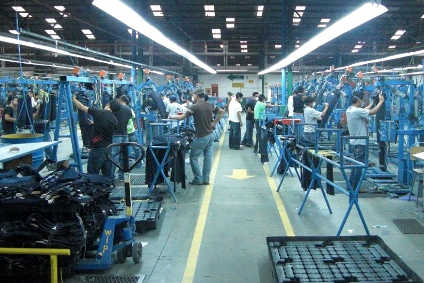
Central American apparel exports are on the up thanks to rising US demand for high-performance synthetic activewear and ongoing uncertainty over Mexico’s position in the North American Free Trade Agreement (NAFTA).
Guatemala’s apparel exports are set to rise 7.5% to just over $1.6bn this year on the back of surging demand for synthetic or man-made fibre apparel, according to Alejandro Ceballos, director at Guatemalan apparel industry trade association Vestex.
The hike is helping boost the Central American nation’s average garment prices to $3.75 per square metre equivalent (SME) from around $3.40 in 2015, he told just-style, adding that other Central American exports are strengthening amid similar dynamics.
“The US economy is strengthening and there has been a change in consumption toward more synthetics”
“We are doing very well in Guatemala,” Ceballos says, adding that last year exports gained just 4% amid slower US demand. “The US economy is strengthening and there has been a change in consumption toward more synthetics.”
On the back of this trend, Guatemala’s export basket is now made up of 60% synthetic and 40% cotton apparel.
The polo-shirt segment is benefiting strongly, Ceballos says, adding that Guatemalan makers are rushing to expand in the sector. “Polos are doing very well, not just T-shirts or basic sports” garments, he adds.

US Tariffs are shifting - will you react or anticipate?
Don’t let policy changes catch you off guard. Stay proactive with real-time data and expert analysis.
By GlobalDataCeballos flagged US fibre producer Unifi (which sells yarn to Guatemalan makers) and sportswear brands such as Nike, which source high-performance sportswear in Central America at much lower prices than in Asia (whose goods must pay a 28% tariff) as the biggest winners of the synthetics frenzy.
Rising investment
Guatemala is party to the seven-nation Dominican Republic-Central American Free Trade Deal (DR-CAFTA) in which textile and apparel goods are traded duty-free with the US.
As the world’s biggest market seeks more value-added activewear products south of the border – shunning Mexico until the North American Free Trade Agreement (NAFTA) undergoes a high-stakes renegotiation – textile investments in the impoverished region are rising.
Ceballos says the influx is also helping lift exports for other Central American countries, which he forecasts are set to surpass last year’s gains. In 2016, DR-CAFTA exports eased to $8.2bn from $8.4bn in 2015, according to Vestex research.
“We are seeing a lot of Asian investment, especially for yarn spinning capacity,” Ceballos explains, adding that Sae-A recently invested in Costa Rica while several players are eyeing similar expenditures in Guatemala.
Honduras is also drawing great interest, while El Salvador’s rising wages and lack of future growth strategy are prompting an exodus with Hanes, Fruit of the Loom and local player Intradeco recently moving factories to Honduras.
“A lot [of Asian] synthetic players see big business in Central America because they know the US taxes will stay for a while and they want to compete with the US suppliers by using DR-CAFTA’s trade advantages,” Ceballos explains.
No progress on NAFTA
On that note, he says
Opportunities are opening for regional suppliers – as long as DR-CAFTA does not itself see an aggressive rejig
DR-CAFTA’s attractiveness is also growing amid rising uncertainty that NAFTA could be nixed, opening opportunities for regional suppliers as long as DR-CAFTA does not itself see an aggressive rejig.
Ceballos believes NAFTA’s fifth negotiation round earlier this month was a failure for Mexico, which is sticking to stated demands that the US maintain the Tariff Preference Level (TPL) to allow it to source key yarn and fabric from outside the region to produce for-export US apparel. It also wants its much richer neighbour to scrap NAFTA’s rule-of-origin in a move that would significantly bolster its competitiveness as exports are down sharply this year.
Samuel Gershevich, president of leading Mexican apparel industry trade association Canaive, refuses to comment on the current state of the negotiations but expresses frustration about the current stalemate – which Fitch Ratings says is increasing the likelihood that the crucial deal could be cancelled, dealing a heavy blow to Mexico’s economic future.
“Nothing happened. It was all about technical stuff and there was no progress,” Gershevich says, adding that he hopes the next meeting in Montreal late January will yield better results.
Sunset hurdle
Trump is demanding Mexico allow the US to buy up to 80% of its auto parts to circle back as cars north of the border to fix a huge trade deficit for the US in that industry – a key compromise Ceballos says could help the textiles and apparel industry win the day, at least on TPL.
“There is a more than 50% chance they could get TPL if they compromise on auto but I don’t think the US will eliminate the rule-of-origin because China will be moving into the neighbourhood,” Ceballos muses.
Another sticking point is Trump’s desire that NAFTA is renegotiated every five years under the so-called sunset provision, something the Mexican delegation is also opposing, according to sources following the negotiations.


